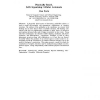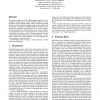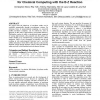19 search results - page 2 / 4 » Merging Cellular Automata for Simulating Surface Effects |
DAI
1998
Springer
13 years 9 months ago
1998
Springer
A physically based system of interacting polyhedral objects is used to model self-assembly and spontaneous organization of complex structures. The surfaces of the polyhedra in the ...
CA
2003
IEEE
13 years 10 months ago
2003
IEEE
We present a simple, linear 3D cellular automata approach for animating the melting process of solid volumetric models. Accurate modelling of object melting usually requires compl...
IPPS
2000
IEEE
13 years 9 months ago
2000
IEEE
Cellular automata can be used to design high-performance natural solvers on parallel computers. This paper describes the development of applications using CARPET, a high-level prog...
ALIFE
2004
13 years 5 months ago
2004
The concept of "self-protection", a capability of an organism to protect itself from exogenous attacks, is introduced to the design of artificial evolutionary systems as...
GECCO
2007
Springer
13 years 11 months ago
2007
Springer
We propose that the behaviour of non-linear media can be controlled automatically through coevolutionary systems. By extension, forms of unconventional computing, i.e., massively ...



